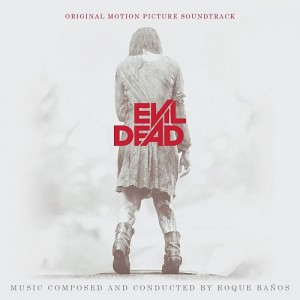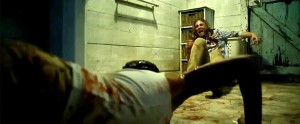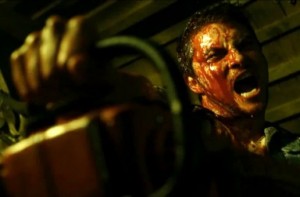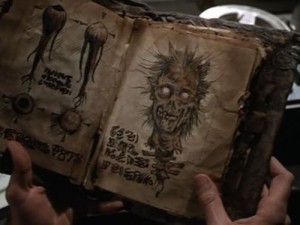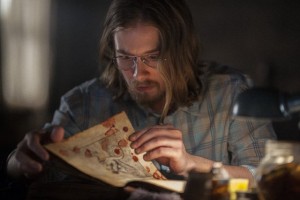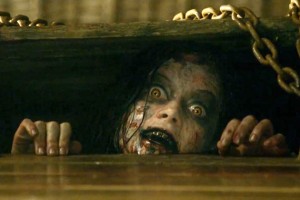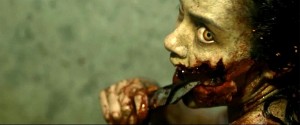There are over the top gore films. There are over the top horror scores. And then there is the redo of EVIL DEAD, which does its best to live up to its claim of being “the most terrifying film you will ever experience.” While that debate will be left up to those who survive its blood-splattered roller coaster ride with enough severed limbs to make RE-ANIMATOR look like REBECCA OF SUNNYBROOK FARM, there will be little argument that Roque Banos’ score is the aural equivalent of a raging exclamation mark, it’s bottom colon fashioned into a knife that repeatedly stabs your ears with its thunderous blend of melody, cacophony and choral chanting that does its damnedest to frighten the living crap out of you.
That Banos succeeds quite brilliantly in a way that’s both hilariously exaggerated and straight-faced snarling is a tribute to the symphonic power wielded by a soft spoken, and very sweet Spaniard. He’s seemingly been hell-bent on putting actual music back into a horror score genre that more often than not comes across with the ear-pleasing appeal of a kitchen-full of metal pans being dumped on the floor. Not that Banos is any less relentless when the calliope killer clowns, Theremin-haunted child killers and faceless lullaby phantasms he’s scored in such genre efforts as THE LAST CIRCUS, THE MACHINIST and THE INTRUDERS. And it certainly doesn’t mean that there isn’t the sometimes nicer, infinitely more stylistic stuff within him to play “800 Bullets’” Spaghetti Western, period adventure in ALATRISTE, or the comic cop antics of the TORRENTE series.
However, it’s horror is likely to prove the key in Banos’ long-deserved attack on the scoring scene, the mood deceptively set with a gentle piano melody that plays the bond between the drug-addled Mia (an excellent Jane Levy) , her brother, and a group of pals that seek her rehab at a cabin in the woods. This is the calm before the storm in Uruguayan writer-director Fede Alvarez’s insane, and very well made revamp (as produced by original EVIL DEAD creators Sam Raimi, Robert G. Tapert and Bruce Campbell for extra geek street cred). But soon enough, as dumb young people do in movies like this, a doofus reads from a barbed-wire bound book with a host of blood-etched warnings not to. Then it’s time for the Kandarian demons to hit the fan, with Banos’ score raging in all abandon, unleashing dissonance that’s nonetheless possessed with actual, smart melody to make the musical insanity all make sense. For those Shemps who think film music should not be heard, Roque Banos is the literal bullhorn that blows their brains out- with a warning shriek that’s likely to put Hollywood on alert to this composer’s increasingly terrifying talent.
ASSIGNMENT X: Were you aware of the EVIL DEAD films before working on the remake?
ROQUE BANOS: Absolutely. I knew them very well. I’m a huge fan of the three of them. I was even very excited when I knew there was going to be a re-make, before I had any idea of who the director was, or any idea if I’d ever have the chance to compose the score.
AX: EVIL DEAD was a hot gig to land. How did you win the project over?
BANOS: That’s a long story! I contacted Fede by Facebook. He rapidly answered my request, and messaged me back very enthusiastically asking if I could compose the score.” Of course!” I said. But the most difficult part was of course trying to convince the producers. Fede put all his effort into that, and used my pre-existing music on the first cut of the movie. When he put that together with his direction, everyone was convinced that I was right for the job.
AX: When a picture is labeled as “the most terrifying film you will ever experience,” how much more difficult does it make the expectations of your score to come, let alone from diehard “Evil Dead” fans and the producers who also made the original?
BANOS: I don’t really know! I guess it’s always a risk to re-make a pre-existing movie, and within it a new score for it. In this case I just thought from the first thematic ideas that everything needed to be totally new. The score had to start from 0 as opposed to number 4. And like all of my work, I put all of my soul into it. I just don’t want to lose my soul getting everyone to like my music!
AX: What do you think makes for “scary” music, and how do you think it’s changed since the time that Joseph LoDuca scored the first EVIL DEAD?
BANOS: Any music could work as being “scary” in my opinion. It just depends on the scene, and the meaning of it when you add the music. I think horror movies have evolved from classic scores that based on symphonic music to ones that were more electronic. I would really like them to go back again to that classical sound, but may be with more contemporary language that could bring new sounds out from the orchestra.
AX: There are barely any laughs in EVIL DEAD other than how over the top its gore is, In that respect, do you think the music acknowledges its own humor by being so in-your-ears?
BANOS: I think the music is really stuck to the picture and some times it enhances it to the highest level, which in turn makes everything “over the top.”
AX: After a certain point into scoring EVIL DEAD, did you realize there was no way not to go over the top?
BANOS: Yeah that’s true. Fede and I always wanted get the scariest music that was possible for the movie. We never thought we went too far, because nothing is too far out for a film like this. The horror had to be extreme.
AX: What do you think the biggest difference between this EVIL DEAD and the original is, and how do you think your score reflects it?
BANOS: It is hard to say. This one is based on the same story, but other aspects of it are very different. I remember that one of the first thoughts that Fede and I had when we discussed the score was the fact that we wanted the people to think this was really happening. We wanted to reflect the truth of this madness. Not only about the gory scenes, but also about human reactions and human feelings to the horror. I think this could be one of the biggest differences in the approach of our work.
AX: One wouldn’t think of hearing a lyrical theme in a film like this. How important was it for you to have that kind of emotional underpinning, especially as embodied by a piano?
BANOS: As I mentioned before, we wanted to reflect the logical human reaction to every scene with the music. Therefore, we not only needed “horror” music, but some sentimental tunes as well. There’s an intrinsic love story in it in the relationship of a brother and sister, both of whom share a turbulent past that the music needed to support. This kind of music also let the movie “breath,” which was necessary with all of the gore.
AX: How difficult is it to balance a horror score’s melodic moments with the kind of screaming, percussive dissonance that typifies today’s genre soundtracks? And do you think you’re doing your part to bring more melody back to them?
BANOS: I don’t really know. I just do my style, and create melodies to movies that I think really need them. But I’ve also made many scores with no melodies at all in them. However I like the use of themes in movies. They might be melodic, or rhythmic, or just a specific sound. But once I give them that thematic nature, I use those motifs throughout the movie. I must say that I particularly like melodies in horror films, because they make them move really fast. I’m convinced they work well in them.
AX: Do you think composing on the often-extreme movies of Alex de la Iglesias like THE LAST CIRCUS has made you immune to the violence in EVIL DEAD? Or were you disturbed to work on this picture day in and day out?
BANOS: I’ve made music for many extreme scenes, but never more so than EVIL DEAD‘s. I had nightmares for the first 2 weeks. And sure, I had to close my eyes several times during that period. But of course, after that, I was immune.
AX: Probably the most unique, and hair-raising instrument in the score is an actual siren, which might be a first for a horror score. How did you hit on that idea?
BANOS: It was coming from those nightmares that I got right when I began to score the film. I spent several nights dreaming about demons chasing me and chopping my body apart! I always awoken suddenly by police sirens. One night I was really annoyed by that siren, and thought it might cause the same impression in the movie, so I made the sample and used it in some places. Fede rapidly loved it, and we started spreading it out through the whole movie. I was really a discovery!
AX: How did you want to use a “Kandarian demon” chorus in this score? And were you worried about writing any vocal incantations that could truly unleash something unholy?
BANOS: I was actually concerned a little bit about it, LOL. But I didn’t worry too much! My good friend Juan Miguel Valero is Dean Professor of Latin at the Salamanca Royal University in Spain, and provided me with some translations from Latin texts. So we got a bunch of Latin phrases that I used in choral parts that corresponded with was happening in the scenes. But never used any satanic verses, or anything close to them. The funny thing was that the recording was made in an old church that re-converted into an amazing recording space called Air Studios, at London. It’s one of the best in the world, together with Abbey Road, in my opinion.
AX: Even though it had a very limited budget, Joseph LoDuca was still able to have an orchestral score for the first EVIL DEAD film. How important was it to carry on the tradition?
BANOS: I’m so glad I had the chance to make it with a big orchestra as well. At the beginning, they had the thought of not using a big orchestration for the movie. But when the producers saw the first cut that used my symphonic music, everyone was amazed enough to go with the idea of making a big gothic score. That orchestral sound was the reason I got the job.
AX: On that note, this EVIL DEAD has a far bigger budget. Do you think that makes the use of a lush, “classy” orchestra more fitting than going for a rawer, and smaller ensemble?
BANOS: I don’t think it was a matter of the budget. Actually they wanted a small group of players at the beginning, but then decided to use a bigger score. I actually used up almost all the music budget because the producers wanted the best option.
AX: Was it easier for you to work with a Latin director?
BANOS: It does not really matter if Fede was Latin or English, because the creative relationship is made by the person. I’ve worked with many directors from different countries and languages, Spanish, French, etc, and the collaboration with all of them has been excellent. I’ve had some cases where the director was from Spain, like me, and it was hard to communicate with him. Anyway, with Fede, it was really phenomenal. He is not just a very talented director, but also a musician who plays the piano very well. So he has a very high sensitive to the music. We had a very fluent communication, and no argument about any decision. After a hard work of work, we’d play some standards- he with piano, and me on the saxophone. We had really good times on EVIL DEAD.
AX: Did your stutter make you more driven to communicate your “voice” through your music? And how difficult has it been dealing with studio executives, and filmmakers, some of whom might be reluctant to hire a composer with a “disability,” especially one that can sometimes make vocal discussion very difficult?
BANOS: I don’t think it matters at all! And people that might have any issue with it are really not worthy to work with. At the beginning of my living in Los Angeles, I was convinced it influenced my career negatively because it was extremely difficult to practice the networking, so necessary in this town to get the gig. But I’m sure now that there are other ways of getting the job, because your own voice comes from your work, which has no disability or handicap.
AX: You’ve been in town for over a year before getting “Evil Dead.” How did you persevere in LA to the point of getting that breakthrough? And based on that, what would you tell to other composers who are “big” in their country, and are now thinking of making the trip to conquer Hollywood?
BANOS: Each situation is very particular. Mine was an investment, I spent all the money I had in my first year here, and fortunately I got this movie, which saved me from going back to Spain. What I would say to the people in my situation? Be patient…
AX: Do you find it ironic that while in Spain you’re known for your often sensitive, and subtle dramatic scores, that in the United States people view you as a “horror” guy?
BANOS: I wouldn’t really feel like working just in horror films, although I know here they give you a label. Of course I’ll do whatever they want me for. As you said, I have a bunch of other styles and scored for movies about adventure, love stories and dramas, so I hope to demonstrate all of that as well over here.
Visit Dark Delicacies on Saturday, April 27 to meet composer Roque Banos and director Fede Alvarez, and have them autograph your EVIL DEAD soundtrack, or order signed copies online HERE
Clink on the link to buy the EVIL DEAD soundtrack
Visit Roque Banos’ website HERE
Follow us on Twitter at ASSIGNMENT X
Fan us on Facebook at ASSIGNMENTX
Article Source: Assignment X
Article: Interview with EVIL DEAD composer Roque Banos
Related Posts:









